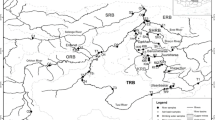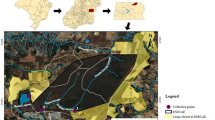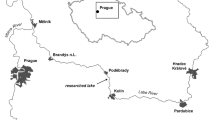Abstract
The maintenance of limnological monitoring programs in the Cerrado Domain is crucial as a provision of useful information about temporal variations in land use and their respective water quality responses, considering its importance as water source for different Brazilian hydrographic basins. The purpose of this research was to describe limnological variables of low-order lotic systems located in the Cerrado Long Term Ecological Research (LTER) site (Environmental Protection Area (APA) Gama and Cabeça de Veado, Federal District of Brazil). Altogether, nine different streams were considered in this study. Samplings were conducted between 2010 and 2012, concentrated in the dry and rainy seasons. The sampling sites were generally characterized by low nutrient concentrations (e.g., medians, TP = 14.8 μg L−1, TN = 20.0 μg L−1, NO3 = 13.8 μg L−1) and slightly acidic waters (median, pH = 5.3), with quite low electrical conductivity values (median = 6.4 μS cm−1). However, water quality degradation as a response to diffuse pollution was reported in some sampling points (e.g., Onça and Gama streams), expressed by relatively higher N and P concentrations, which were probably highlighted by the good water quality of the data set as whole. Although there was a trend to higher values of nitrogen forms during the dry season, significant statistical differences between the seasonal periods were reported only for the variables temperature and dissolved silica, which were higher in the dry and rainy season, respectively. The streams located in the preserved areas inside the ecological stations of APA Gama and Cabeça de Veado can still be considered good examples of reference lotic systems in the Cerrado Domain; notwithstanding, this study reported incipient signs of water quality degradation which cannot be overlooked in future limnological monitoring.




Similar content being viewed by others
References
APHA. (2005). Standard methods for the examination of water and wastewater (21st ed.). Washington, DC: American Public Health Association.
Barbosa, F. A. R., Scarano, F. R., Sabará, M. G., & Esteves, F. A. (2004). Brazilian LTER: ecosystem and biodiversity information in support of decision-making. Environmental Monitoring and Assessment, 90, 121–133.
Biggs, T. W., Dune, T., & Martinelli, L. A. (2004). Natural controls and human impacts on stream nutrient concentrations in a deforested region of the Brazilian Amazon basin. Biogeochemistry, 68, 227–257.
Bispo, F. H. A., Silva, A. C., & Torrado, P. V. (2011). Highlands of the upper Jequitinhonha Valley, Brazil. I – Characterization and Classification. Revista Brasileira de Ciência do Solo, 35, 1069–1080.
Bustamante, M. C. C., Medina, E., Asner, G. P., Nardoto, G. B., & Garcia-Montiel, D. C. (2006). Nitrogen cycling in tropical and temperate savannas. Biogeochemistry, 7, 209–237.
Bustamante, M. M. C., Nardoto, G. B., Pinto, A. S., Resende, J. C. F., Takahashi, F. S. C., & Vieira, L. C. G. (2012). Potential impacts of climate change on biogeochemical functioning of Cerrado ecosystems. Brazilian Journal of Biology, 72, 655–671.
Carvalho, F. M. V., Marco Júnior, P., & Ferreira, L. G. (2009). The Cerrado into-pieces: habitat fragmentation as a function of landscape use in the savannas of central Brazil. Biological Conservation, 142, 1392–1403.
Chaves, H. M. L., & Santos, L. B. (2009). Ocupação do solo, fragmentação da paisagem e qualidade da água em uma pequena bacia hidrográfica. Revista Brasileira de Engenharia Agrícola e Ambiental, 13, 922–930.
CNPq. National Counsel of Technological and Scientific Development (2013) Available at: http://www.cnpq.br/web/guest/apresentacao7 (Last accessed: 27 August 2013) (In Portuguese).
Cunha, D. G. F., Dodds, W. K., & Calijuri, M. C. (2011). Defining nutrient and biochemical oxygen demand baselines for tropical rivers and streams in São Paulo State (Brazil): a comparison between reference and impacted sites. Environmental Management, 48, 945–956.
Dodds, W. K. (2006). Eutrophication and trophic state in rivers and streams. Limnology and Oceanography, 51, 671–680.
Filoso, S., Martinelli, L. A., Howarth, R. W., Boyer, E. W., & Dentener, F. (2006). Human activities changing the nitrogen cycle in Brazil. Biogeochemistry, 79, 61–89.
Fonseca, B. M., Mendonça-Galvão, L., Padovesi-Fonseca, C., Abreu, L. M., & Fernandes, A. C. M. (2013). Nutrient baselines of Cerrado low-order streams: comparing natural and impacted sites in the Central Brazil. Environmental Monitoring and Assessment. doi:10.1007/s10661-013-3351-8.
GDF. Government of the Federal District (2012) Available at: http://www.agricultura.df.gov.br/noticias/item/2364-núcleo-rural-córrego-da-onça.html (Last accessed: 26 November 2013) (In Portuguese).
Gücker, B., Boëchat, I. G., & Giani, A. (2009). Impacts of agricultural land use on ecosystem structure and whole-stream metabolism of tropical Cerrado streams. Freshwater Biology, 54, 2069–2085.
Hilton, J., O’Hare, M., Bowes, M. J., & Jones, J. I. (2006). How green is my river? A new paradigm of eutrophication in rivers. The Science of the Total Environment, 365, 66–83.
Lewis, W. M., Jr., Melack, J. M., McDowell, W. H., McClain, M., & Richey, J. E. (1999). Nitrogen yields from undisturbed watersheds in the Americas. Biogeochemistry, 46, 149–162.
Lima, J. E. F. W., & Silva, E. M. (2007). Estimativa da contribuição hídrica superficial do Cerrado para as grandes regiões hidrográficas brasileiras. XVII Simpósio Brasileiro de Recursos Hídricos, 2007, São Paulo. Anais do XVII Simpósio Brasileiro de Recursos Hídricos (p. 13pp). Porto Alegre: ABRH. In Portuguese.
Lorenz, A. W., & Feld, C. K. (2013). Upstream river morphology and riparian land use overrule local restoration effects on ecological status assessment. Hydrobiologia, 704(1), 489–501.
Myers, N., Mittermeier, R. A., Mittermeier, C. G., Fonseca, G. A. B., & Kent, J. (2000). Biodiversity hotspots for conservation priorities. Nature, 403, 853–858.
Nardoto, G. B., & Bustamante, M. M. C. (2003). Effects of fire on soil nitrogen dynamics and microbial biomass in savannas of Central Brazil. Pesquisa Agropecuária Brasileira, 38(8), 955–962.
Pardo, I., Gómez-Rodríguez, C., Wasson, J.-G., Owen, R., van de Bund, W., Kelly, M., Bennett, C., Birk, S., Buffagni, A., Erba, S., Mengin, N., Murray-Bligh, J., & Ofenböeck, G. (2012). The European reference condition concept: a scientific and technical approach to identify minimally-impacted river ecosystems. The Science of the Total Environment, 420, 33–42.
Parron, L. M., Bustamante, M. M. C., & Markewitz, D. (2011). Fluxes of nitrogen and phosphorus in a gallery forest in the Cerrado of central Brazil. Biogeochemistry, 105, 89–104.
Pivello, V. R., Oliveras, I., Miranda, H. S., Haridassan, M., Sato, M. N., & Meirelles, S. T. (2010). Effects of fires on soil nutrient availability in an open savanna in Central Brazil. Plant and Soil, 337, 111–123.
Reatto, A., & Martins, E. S. (2005). Classes de solo em relação aos controles da paisagem no bioma Cerrado. In A. Scariot, J. C. Sousa-Silva, J. M. Felfili (Orgs.), Cerrado: Ecologia, Biodiversidade e Conservação (pp 49–59). Brasília: Ministério do Meio Ambiente (in Portuguese).
Resende, J. C. F., Markewitz, D., Klink, C. A., Bustamante, M. M. C., & Davidson, E. A. (2011). Phosphorus cycling in a small watershed in the Brazilian Cerrado: impacts of frequent burning. Biogeochemistry, 105, 105–118.
Ribeiro, J. F., & Walter, B. M. T. (2008). As principais fitofisionomias do Bioma Cerrado. In S. M. Sano, S M. P. Almeida, J. F. Ribeiro (Eds.), Cerrado: Ecologia e Flora (pp 151–212). Brasília: Embrapa Informação Tecnológica (in Portuguese).
Silva, D. M. L., Ometto, J. P. B., Lobo, G. A., Lima, W. P., Scaranello, W. A., Mazzi, E., & Rocha, H. R. (2007). Can land use changes alter carbon, nitrogen and major ion transport in subtropical Brazilian streams? Science in Agriculture, 64(4), 317–324.
da Silva, F. A. M., Assad, E. D., & Evangelista, B. A. (2008). Caracterização climática do bioma Cerrado. In S. M. Sano, S M. P. Almeida, J. F. Ribeiro (Eds.), Cerrado: Ecologia e Flora (pp 69–87). Brasília: Embrapa Informação Tecnológica (in Portuguese).
Silva, J. S. O., Bustamante, M. M. C., Markewitz, D., Krusche, A. V., & Ferreira, L. G. (2011). Effects of land cover on chemical characteristics of streams in the Cerrado region of Brazil. Biogeochemistry, 105, 75–88.
Smith, R. A., Alexander, R. B., & Schwarz, G. E. (2003). Natural background concentrations of nutrients in streams and rivers of the conterminous United States. Environmental Science and Technology, 37, 2039–3047.
UNESCO. Organização das Nações Unidas para a Educação, a Ciência e a Cultura. (2003). Subsídios ao zoneamento da APA Gama e Cabeça de Veado e Reserva da Biosfera do Cerrado: caracterização e conflitos socioambientais. Brasília: UNESCO, MAB, Reserva da Biosfera do Cerrado. In Portuguese.
Vendrame, P. R. S., Brito, O. R., Guimarães, M. F., Martins, E. S., & Becquer, T. (2010). Fertility and acidity status of latossolos (oxisols) under pasture in the Brazilian Cerrado. Anais da Academia Brasileira de Ciências, 82(4), 1085–1094.
Wantzen, K.M. (2003). Cerrado streams—characteristics of a threatened freshwater ecosystem type on the Tertiary Shields of Central South America. Amazoniana, XVII (3/4), 481–502.
Wantzen, K. M., Siqueira, A., Cunha, C. N., & Sá, M. F. P. (2006). Stream-valley systems of the Brazilian Cerrado: impact assessment and conservation scheme. Aquatic Conservation: Marine and Freshwater Ecosystems, 16, 713–732.
Acknowledgments
This study was sponsored by the National Counsel of Technological and Scientific Development (CNPq) (Process 558233/2009-0). We give our thanks to the Catholic University of Brasília (UCB) for the scholarships granted to undergraduate students and for the chemical analysis (especially to the environmental engineers Rodrigo Zollini and Diego Nascimento); Francisco Diogo Rocha Sousa for the maps of the study area; the Department of Ecology of the University of Brasília (UnB) for the transport during field work; and the administration staffs of FAL, RECOR, and JBB for their support within these areas. We are also grateful to our colleagues from Grupo de Estudos de Ecossistemas Aquáticos (GEEA) involved in field and laboratory work, especially to the undergraduate students.
Author information
Authors and Affiliations
Corresponding author
Rights and permissions
About this article
Cite this article
Fonseca, B.M., de Mendonça-Galvão, L. Pristine aquatic systems in a Long Term Ecological Research (LTER) site of the Brazilian Cerrado. Environ Monit Assess 186, 8683–8695 (2014). https://doi.org/10.1007/s10661-014-4035-8
Received:
Accepted:
Published:
Issue Date:
DOI: https://doi.org/10.1007/s10661-014-4035-8




